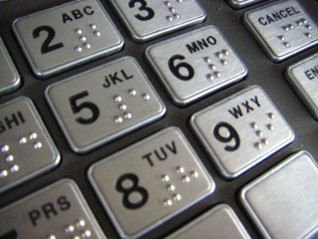
Louis Braille once wrote: “Access to communication in the widest sense is access to knowledge.” The raised dot system he developed has been a powerful and liberating tool for people with vision loss since the early 1900s.
January is Braille Literacy Month, but the opportunity to learn braille is now a year-round thing at the Council. Braille instruction is one of the newest additions to our suite of Vision Services.
“I was in elementary school when I started to learn braille,” says Certified Vision Rehabilitation Therapist Rachel Pavone of the Council. Rachel teaches braille in the Council’s onsite Vision Rehabilitation Classroom as well as during home visits.
Rachel emphasizes that gaining even very basic braille skills can improve one’s quality of life. Printing braille labels for kitchen items, from soup cans to oven knobs, is one simple example. Others are the ability to read elevator buttons and room signs, many of which include braille.
In spite of these benefits, braille literacy has declined sharply in recent years, and the percentage of individuals with vision loss who read braille is at an all-time low. In 1960 nearly half of all students who were blind were fluent in Braille. In 2016, according to the most recent data available from the braille advocacy organization BrailleWorks, only 8.5% of students identified as braille readers.
Rachel believes there are a number of reasons why braille proficiency numbers have fallen so low. In part, it reflects the increasing use of technological tools, such as screen reader software. Many young students who are blind are handed reading materials in the form of audio recordings. When it comes time to give answers, they have someone else write out their responses. It’s a process that can move the student farther from a physical interaction with print.
Sometimes there are physical limitations that prevent a person from reading braille. For example, a person with neuropathy and numbness in their hands may not have the necessary fingertip sensitivity to discern dot patterns.
Rachel says cost can also be a barrier for some beginning braille students. “When it comes to being a braille user, if you want to take notes it’s going to require an expense. A brailler, braille paper. But there are options out there for people, and we work with them at the Council.” For example, Rachel says braille paper and supplies are all provided to students during their braille instruction with the Council. Students are also advised about how to look for an affordable brailler.
Then there’s the misconception that learning braille is just too hard. “Some people think it’s really complicated, and they just can’t do it,” Rachel says. “That’s not the case. We can tailor the instruction.” Rachel says it’s all about helping each individual build the foundation for the braille journey that is most appropriate for them, whether that journey involves just learning the basics or ultimately advancing to a higher level of proficiency.
Braille instruction at the Council is one-on-one, individualized to meet each learner’s goals. The Council provides the necessary supplies for in-class instruction, including flash cards, reading materials, braille paper and access to a brailler while working in the Council’s classroom.
To learn more about braille instruction at the Council and find out if braille is right for you, contact the Council at 608 255-1166 or Info@WCBlind.org.

